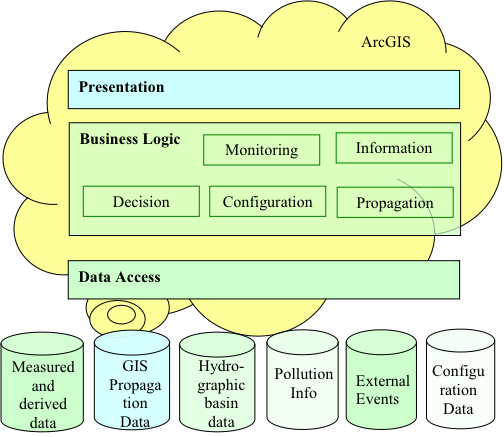D1.1 Technology survey: Prospective and challenges - Revised version (2018)
4 ICT based systems for monitoring, control and decision support
4.9 Information-centric systems (ICS) for watershed investigation and management
Recent advances in information science and cyber-infrastructure have set the stage for a new information-knowledge generation technology that can facilitate an “information-centric” approach for watershed investigation and management that capitalizes on observations and their interpretation [Marmorek, 2003]. This new approach differs fundamentally from the “observation-centric” and “model-centric” strategies of the past, whereby water cycle components were viewed independently and uncorrelated with the bio-geo-chemical processes supported by it. Systematic integration of the water-relevant data into a dedicated system allows to uniquely couple hydroscience information with other water-allied disciplines, such as economics, political and social sciences, in a common information system [Waters, 2008], [Lee, 1993] and management practice. These integrative systems enhance the understanding of ecosystems and the management of the natural and built environment through a participatory approach that ensures continuous stakeholder involvement.
There is a wide variety of users and associated interests and some of the tools for handling data and information to support management and policy developments during IWRM implementation. It includes managers, accountants, engineers, operators, solicitors, surveyors or scientists. At this time, there is no unified vision on the components, their role and functions, and the enabling technologies to accomplish integrative management approaches. Moreover, there is no guidance of what components should be developed first and in what integration order. It is emphasized herein, that IWRM is not just a conceptual and academic exercise and it can be only attained by giving proper consideration to the nature of information requirements to support IWRM and by identifying the “enabling technology” to fulfill those requirements as one of the first priority. The need to set data and information for supporting IWRM as a high priority was clearly documented in [Muste, 2010]. It can be said that the lack of progress in informatics-related aspects of IWRM may be part of the slow implementation pace perceived by some of its critics. Overlooking of the above aspects contrasts with the considerable intellectual and financial efforts carried out to clarify IWRM concepts and functions and for putting in place the necessary political structure and institutional framework for IWRM implementation. It is quite obvious that the fully integrated water resources management is not limited by a lack of conceptual framework, but because the operational problems have not received sufficient attention in the past.
Hydroinformatics-based systems are computer-centered platforms quasi-equivalent to CI-based ones focused on water related problems in the environment, therefore the terms are interchangeable. These integrate CI tools and methods in a digital environment that facilitates the conversion of the data into information and subsequently into knowledge through customized workflows. The fusion of data and numerical simulation is the most powerful tool to generate information that managers use to monitor, predict, and warn the public in extreme events. Recently, data-driven modelling is increasingly used for the same purposes [Damle, 2007]. Engineers continue to have important responsibilities to build, calibrate, verify, validate and apply models. Collaborative models are also used for prediction, assessments of alternative scenarios, and multi-criteria indicators that are also used for the decision-making process.
In the last two decades, the decision-making in water resources systems management has been influenced by the introduction of the sustainability paradigm [Simonovic, 2009]. Savenije and Hoekstra [Savenije, 2002] indicate that the watershed sustainability is only accomplished when the resource base and water use are each sustainable. The first aspect is accomplished by closing of the water, nutrient, soil and energy cycles, building up societal assets (know-how, knowledge, technology, infrastructure welfare, civic society, educational and legislative capacity). The second one is reached by imposing zero tolerance on pollution, complete recycling (agriculture, industry, household), water conservation and retention, water sector reform (good governance and institutional framework, education, participation).
Some of the most important ICS contributions to sustainable management of watersheds are:
- Improvement of the information services;
- Development of operational science for decision making;
- Enhancing the human dimension in the management process;
- Supporting capacity building;
- Fostering institutional and governance adjustments.
Figure 12. ArcGIS architecture.
